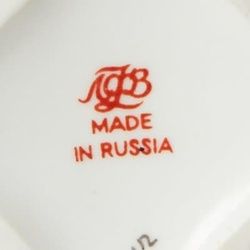
История Ломоносовского Фарфорового Завода (ЛФЗ).
Знаменитый Русский фарфоровый завод был основан в 1744 году XVIII века императрицей Елизаветой Петровной, дочерью Петра Первого Великого. А русский ученый Дмитрий Виноградов, после многолетних исследований, открыл секрет изготовления фарфора и разработал технологию его производства. Надо сказать, что в то время секрет фарфора был известен только китайским ремесленникам. Только саксонской алхимик Дж. Bottger открыл способ производства "европейского" Твердого фарфора. Петр Великий, посетивший европейские страны и интересовавшийся всеми современными изобретениями, весьма заинтересовался секретами изготовления фарфора. Он велел ввезти его в Россию с помощью иностранных ремесленников, но безуспешно. Идея Петра I о создании собственного производства фарфора имела успех после его смерти. Его дочь императрица Елизавета (1741-1761) наняла ученого Дмитрия Виноградова, который использовал местное сырье - глину из Гжели и Олонецкий кварц с алебастром. Кредитовал затею также Виноградов создав для обучения первые русские мастерские по производству фарфоровых изделий.
Изначально, завод принадлежал династии Романовых и производил посуду и иные предметы из фарфора исключительно для русского царя. Позднее, в середине 19 века, был переименован в "Фарфоровый завод Императора". Завод обеспечивал потребности двора Его Величества Царя и, по сравнению с частными фарфоровыми заводами, практиковал мелкосерийное производство. Продукция была чрезвычайно дорогостоящая и очень редко выставлялась на продажу.
По случаю столетия со дня основания завода был открыт музей фарфоровых изделий, экспозиция которого содержат сейчас 20000 экспонатов, отражающих эволюцию художественного производства фарфора. Предметы, изготовленные в период с 1750 по 1820 год, при участии выдающихся мастеров из Академии художеств, занятых в проектировании и оформлении фарфора, представляют особый интерес. Позже связи между фабрикой и Академией художеств резко сократились и художественное качество изделий и технологии их производства ухудшилось.
В начале 19 века завод реконструирован и начато производство сложных и крупногабаритных изделий из фарфора.
В 1915 году в связи с Первой Мировой войной, характер продукции завода стремительно изменился и завод перешел к производству лабораторных сосудов, жаропрочных фарфоровых трубок, свечей зажигания и т.д.
После 1917 года, когда большевики пришли к власти завод был национализирован и переименован в «Государственные фарфоровый завод".
В 20-е годы усилия Завода были сосредоточены на развитии технологий и промышленного производства самых сложных изделий, предназначенных для технических целей, и на разработку и производство фарфора с агитационной символикой, который был сопоставлен с этим периодом в жизни Советского государства. Посуда производства первых пост-революционных лет экспонировались за рубежом. Экспонаты, произведенные на фабрике выиграли в 1925 золотую медаль на Всемирной выставке в Париже и некоторые отдельные художники были награждены серебряными медалями за свои произведения.
В 1925 по случаю 200-летия Российской академии наук, завод был снова переименован и ему дали имя основателя академии, Михаила Ломоносова. И завод стал называться "Ленинградский фарфоровый завод им. М.В. Ломоносова" (ЛФЗ аббревиатура происходит от названия фабрики на русском - Ленинградский Фарфоровый Завод, или неофициально, - Ломоносовский фарфоровый завод).
Фабрика производит разнообразный ассортимент посуды из фарфора - чайные, кофейные сервизы различных форм и декора, бокалы, чашки, блюдца и презентационные наборы, вазы для цветов, скульптуры (в основном представляющие животных), графины для вина и всевозможные сувениры. До 500 линий одновременно в производстве. Все сложные рисунки осуществляются на фарфоре свободной ручной росписью, а простые графические модели переносятся на предметы с помощью разноцветных тканей, а затем расписываются художниками.
Ломоносовский завод является первым в стране внедрившим технологию и наладившим производство тонкостенных фарфоровых изделий, которые отличаются повышенной белизной, тонкостью и прозрачностью по сравнению с традиционным твердым фарфором.
Фарфоровые изделия с торговой маркой "LFZ" хорошо известны в 30 странах. Они экспортируются в Бельгию, Канаду, Данию, Англию, Финляндию, Францию, Германию, Голландию, Японию, Италию, США и другие страны.







